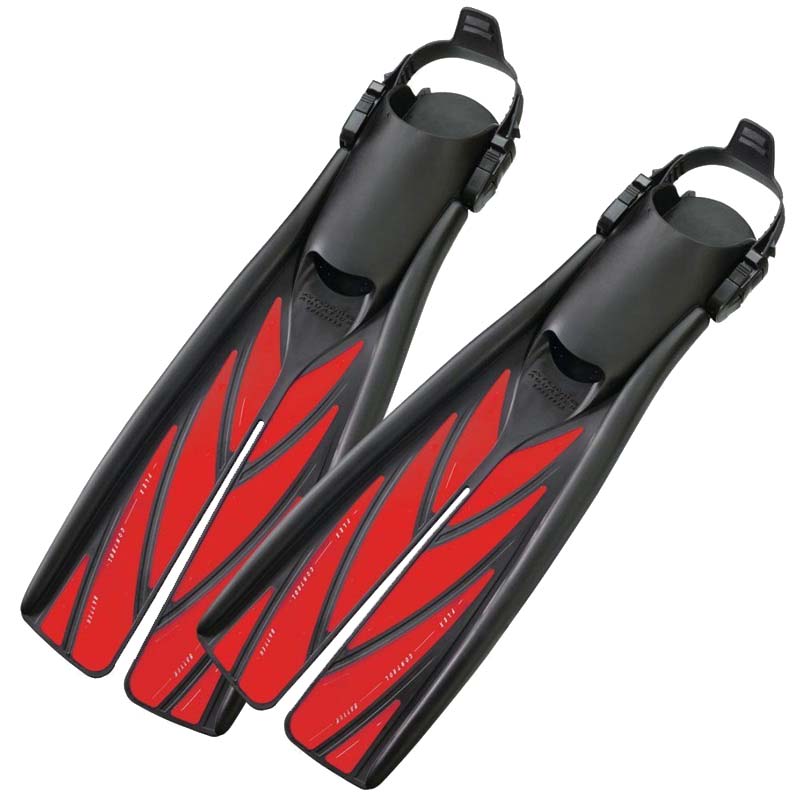Scuba Split Fins: Confronting the Rumors and Embracing the Benefits
Posted by Dive Professional: Will Taylor on on Oct 25th 2023
Fins are a crucial part of a diver's gear, influencing mobility, efficiency, and overall experience underwater. In recent years, split fins have become a topic of heated discussion within the diving community. While some divers swear by their efficiency, others remain skeptical, fueled by persistent rumors and misconceptions. This article aims to address these negative rumors head-on, shedding light on the actual benefits of scuba split fins. In the second part, we will explore the undeniable advantages of standard blade fins, providing a balanced perspective on this essential diving equipment.
Rumor 1: Lack of Power
One of the most prevalent rumors surrounding split fins is that they lack the power needed for strong currents and challenging dive conditions. Critics argue that the split design hampers a diver's ability to exert force, potentially leading to dangerous situations.
The Reality: Efficient Energy Transfer
In truth, split fins are designed for optimal energy transfer. The split in the blade works to create lift and propulsion, allowing divers to move through the water with less effort. While they may not provide the brute force of standard blade fins, they offer a more efficient kick cycle, preserving energy and reducing fatigue over long periods.
Benefit: Enhanced Endurance
Divers who have embraced split fins often report enhanced endurance, attributing it to the fins' efficient design. This efficiency is particularly beneficial for recreational divers, photographers, and those engaged in extended underwater activities, ensuring that they can enjoy their dive to the fullest without being hampered by fatigue.
Rumor 2: Ineffective for Alternate Kicking Styles
Critics of split fins also point to their supposed ineffectiveness for alternate kicking styles, such as frog kicks or helicopter turns, arguing that these maneuvers require the solid blade of standard fins.
The Reality: Adaptability and Learning Curve
While split fins are indeed optimized for flutter kicks, many divers have found them adaptable to various kicking styles with practice. The learning curve may be steeper, but the adaptability of split fins should not be underestimated. Many divers are able to do a modified frog kick with split fins.
Benefit: Versatility in the Water
With the right technique, split fins can offer a surprising level of versatility in the water, catering to different diving scenarios and personal preferences. Divers who have taken the time to master alternate kicking styles with split fins often speak of their satisfaction, highlighting the fins' unexpected flexibility.

Rumor 3: Fragility and Short Lifespan
Another common rumor is that split fins are fragile and have a shorter lifespan compared to standard blade fins. This perception is fueled by the split fins' more complex design and the assumption that more parts equate to more potential points of failure.
The Reality: Durability and Quality Construction
In reality, many split fins are constructed with high-quality materials and advanced engineering, ensuring durability and a long lifespan. Like any piece of diving equipment, proper care and maintenance are key to preserving their condition.
Benefit: Long-Term Investment
Investing in a good pair of split fins can prove to be a wise decision in the long run. Their efficiency and reduced strain on the diver's legs can contribute to a longer and more enjoyable diving career, making them a valuable asset for passionate divers.
Rumor 4: Prohibitive Cost
The final rumor to address is the perception that split fins are prohibitively expensive, putting them out of reach for many divers.
The Reality: Value for Money
While split fins can carry a higher price tag than some standard blade fins, their value extends beyond the initial investment. The benefits of reduced fatigue, enhanced endurance, and efficient energy transfer contribute to a superior diving experience, justifying the cost for many.
Benefit: Investment in Comfort and Performance
Divers who choose split fins are investing in their comfort and performance underwater. The enhanced efficiency and reduced strain on the legs can transform a dive, making every penny spent on quality split fins a worthwhile investment.
Conclusion
In the realm of scuba diving, the choice between split fins and blade fins is a personal one, influenced by individual preferences, diving conditions, and experience level. Split fins offer efficiency, reduced fatigue, and a smooth diving experience, countering the negative rumors with tangible benefits. Blade fins provide power, control, and versatility, catering to technical divers and those seeking stability in challenging conditions.
By weighing the pros and cons of each fin type and considering the specific needs of their diving adventures, divers can make an informed choice, ensuring a safe, enjoyable, and rewarding experience underwater.

